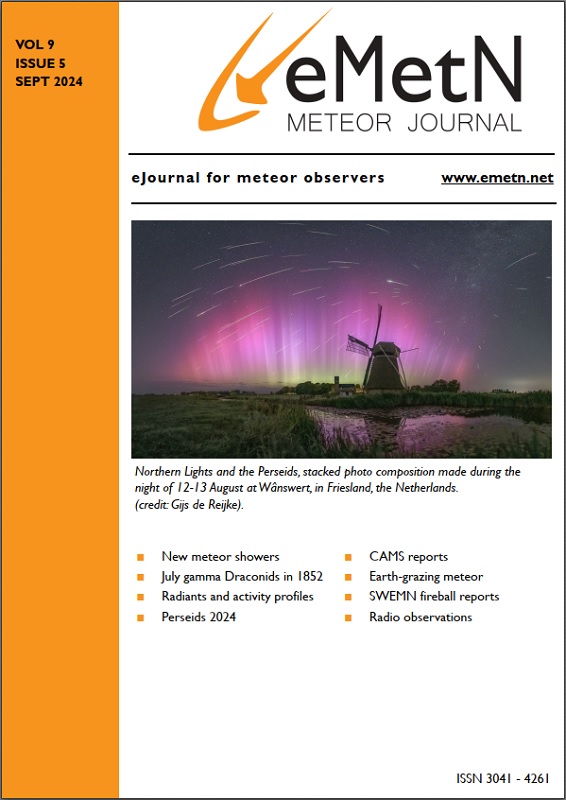Abstract: The problem with the IAU MDCSD meteor shower table is that users may assume that the meteor showers listed in the table exist exactly as they appear in the list. 0027KSE is rated as an “established shower” but KSE03, which was used as a standard in the previous paper, has been deleted. However, 0839PSR00, located next to KSE03, is in “working status” but is active too. The relationship between KSE and PSR will be explained in detail below. Although there are many similar cases, we will limit the scope related to this paper and explain those in which “Part I, Research methods and summary of survey results” alone may lead to misunderstandings. When a simple explanation is sufficient, it has been supplemented in “Part III, Radiant point distribution map and activity profile.” The following 14 cases will be discussed in this Part II.
- 0027KSE and 0839PSR.
- 0040ZCY and 0348ARC.
- 0061TAH: How to name a meteor shower related to Jupiter family comet?
- 0372PPS and neighbor activities
- 0165SZC and 0370MIC
- 0012KCG and neighbor activities: 0012KCG, AXD, 0073ZDR and 0197AUD
- 0033NIA and 0215NPI
- The tail of Orionids
- 0081SLY00 and 0081SLY01
- 0480TCA and 0481OML
- The subdivisions of 0002STA and 0017NTA
- 0338OER and 0490DGE
- 0340TPY00 and 0340TPY01
- 0096NCC and 0097SCC
1 0027KSE and 0839PSR
The first observations of KSE were just four photographic meteors captured by Super Schmidt cameras (McCrosky and Posen, 1959). However, no corresponding meteor shower has been found in current video observations. The position of the PSR matches the position of the photographed meteors, but its activity period is about 10 degrees later in solar longitude. Figure 1 shows meteor activity in the range of λʘ = 10~30° centered on PSR (λ–λʘ, β) = (211.69°, 34.29°). Figure 1 (left) shows GMN observations, and Figure 1 (right) shows IAU MDCSD’s KSE with boxes (target), other meteor showers with crosses, and photographed meteors with circles (among them, those marked as KSE are circled in red). The radiant points of IAU MDCSD that appear in Figure 1 (right) are shown in Table 1.
Although PSR seems to be able to be identified with KSE, the activity profile of PSR is narrow (see 0839PSR in Part III), and therefore the activity at the average KSE of photographic observation λʘ = 14.7° is inconceivable. IAU MDSD currently has three KSE registrations, but both KSE00 and KSE01 are based on these four photographic meteors. KSE02 is observed by CAMS at the upper left of the 3-degree circle, and it can be assumed that this is a combination of PSR and the activity at the upper left of the 6-degree circle in Figure 1 (left). This 6-degree circle activity corresponds to KSE03 observed by CAMS (deleted in the current IAU MDCSD). For reference, Figure 2 shows the activity profile estimated by performing the same processing as for other meteor showers based on KSE03. Many radiant points can be obtained in this region through both video and photographic observations (Figure 1 (right)). What was identified as a KSE by photographic observations may be a chance association of sporadic meteors, or it may have been active half a century ago and is no longer visible.
SonotaCo Net and GMN both have PSR. Interestingly, GMN uses KSE03, which has now been deleted from the IAU MDCSD, as the KSE entry.
Table 1 – The radiant points of IAUMDCSD and four photographic KSE meteors (circles in red in Figure 1 (right)). Code for photographic meteors, see Koseki (2009).
| Code | λʘ | λ–λʘ | β | vg | Distance | Angle | x | y |
| 0027KSE00 | 14.7 | 207.7 | 35.1 | 45 | 3.36 | 285 | 3.26 | 0.84 |
| 0517ALO00 | 15.5 | 226.9 | 22.1 | 55.7 | 18.06 | 128 | -14.18 | -11.19 |
| 0027KSE01 | 15.7 | 209.9 | 33.3 | 45.01 | 1.84 | 236 | 1.53 | -1.03 |
| 0841DHE00 | 19.5 | 232.1 | 46.3 | 49.5 | 19.53 | 46 | -14.07 | 13.54 |
| 0027KSE02 | 20 | 213.7 | 36.6 | 46.7 | 2.79 | 35 | -1.6 | 2.29 |
| 0836ABH00 | 20.3 | 223.1 | 44.6 | 47.5 | 13.5 | 37 | -8.12 | 10.79 |
| 0839PSR00 | 25.1 | 211.7 | 34.3 | 46.3 | 0 | 0 | 0 | 0 |
| H1-10366 | 11.7 | 212.2 | 37.5 | 42 | 3.21 | 7 | -0.41 | 3.18 |
| H1-10389 | 12.7 | 212 | 35.6 | 44.4 | 1.29 | 10 | -0.22 | 1.28 |
| H1-10099 | 16.7 | 206.5 | 33.1 | 46.5 | 4.49 | 256 | 4.36 | -1.1 |
| H1-7092 | 17.7 | 201.2 | 31.9 | 46.7 | 9.14 | 258 | 8.93 | -1.97 |
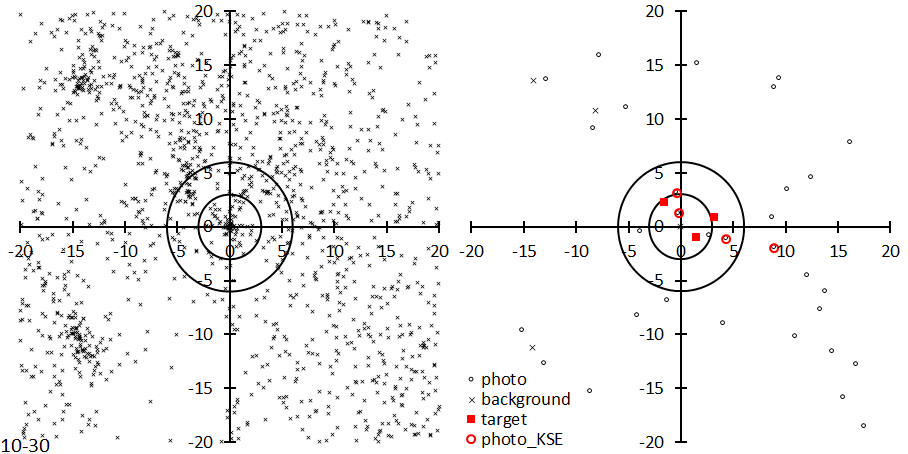
Figure 1 – Radiant point distribution around KSE. GMN (left), IAU MDCSD and photographic meteors (right).
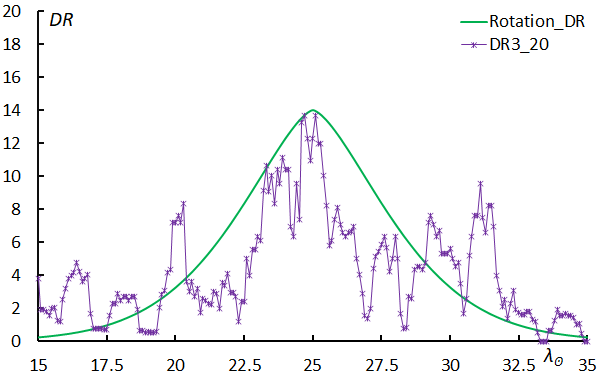
Figure 2 – Activity profile estimate based on KSE03.
2 0040ZCY and 0348ARC
ZCY (zeta-Cygnids) was originally numbered #40 for two similar meteors out of 413 photographed meteors measured by Jacchia and Whipple in their “precision orbit” (Jacchia and Whipple, 1961). Jenniskens combined this with radar observations of Sekanina (1976), which was more than 10 degrees away (Jenniskens, 2006). Currently, an activity different from the photographic observation #40 is called 0040ZCY.
Figure 3 (left) shows the radiant point distribution by GMN for the period λʘ = 0° to 50°, centered on (λ–λʘ, β) = (307°, 59°). 0040ZCY, 0348ARC (April rho-Cygnids), and 0409NCY (nu-Cygnids) all exist in a messy radiant point distribution. If we divide the radiant point distribution into 5-degree increments based on the solar longitude, the ARC can be relatively clearly distinguished from surrounding activities. On the other hand, the activity of ZCY appears to be divided into two groups, one around λʘ = 15° (ZCY01) and one around λʘ = 30° (ZCY02), based on the activity profile.
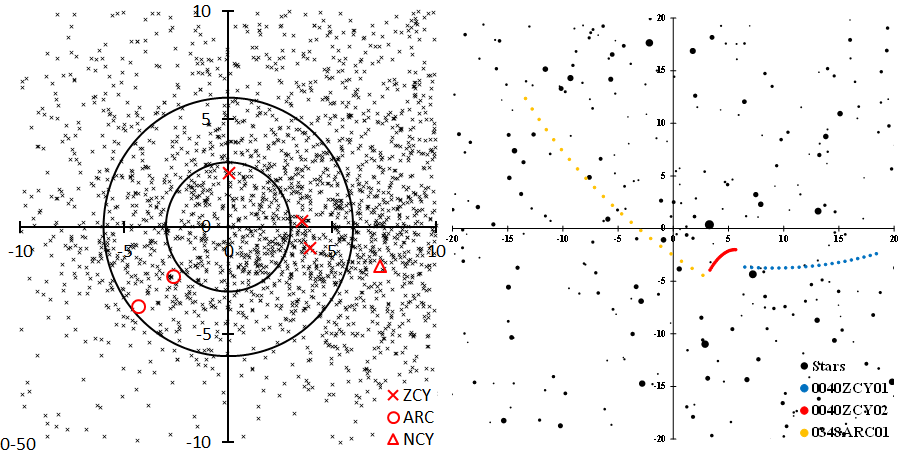
Figure 3 – Radiant point distribution around ZCY and ARC. GMN (left), radiant point movement path estimated in this paper (right).
For this reason, this paper divides the activities into three: ZCY01 (λʘ = 5°~25°), ZCY02 (λʘ = 20°~40°), and ARC00 (λʘ = 30°~50°). Figure 3 (right) represents the movement of the radiant point during each period. ZCY01 and ARC00 are moving from right to left (west to east) on the diagram, but ZCY02 is moving strangely, almost stationary, and moving from bottom to top (slightly left to right). However, it is ZCY02 whose activity profile shows a clear increase and decrease.
Considering the radiant shift, the activities of ARC and ZCY02 are close in the range of λʘ = 30° to 35°, and the possibility that ZCY01 is connected to ARC via ZCY02 cannot be denied. The strange movement of the radiant point of ZCY02 may be due to interference between ZCY01 and ARC. The activity profiles of ZCY01 and ARC are influenced by the activity of ZCY02.
As seen in Figure 3 (left), the surrounding sporadic meteors are highly active, and further observations are required to draw firm conclusions. 0409NCY might be part of the sporadic meteor activity or ZCY.
Neither ZCY nor ARC appears in the J14 list of SonotaCo net. GMN lists two, but ZCY is grouped as one.
3 0061TAH: How to name a meteor shower related to a Jupiter family comet
In 2022, meteoroid particles ejected from 73P/Schwassmann-Wachmann 3 encountered Earth, resulting in an active meteor shower (Koseki, 2022). However, it is not appropriate to call these TAH (tau-Herculids).
One is that TAH is a meteor shower that was detected and named by Southworth and Hawkins (1963) from photographic observation using DSH and has a very large spread of radiant points. Figure 4 (left) shows the distribution of radiant points obtained by photographic observations with IAU MDCSD radiants during the period from λʘ = 57.6° to 87.6°, centered at (λ–λʘ, β) = (135.51°, 54.79°) of TAH00. Tau Herculids was named after the two photographic meteors marked with diamonds in Figure 4 (left). Later, Lindblad (1971) thought that the meteor shower consisting of 14 photographed meteors marked with plusses was the same, and this also came to be called tau Herculids (TAH00). However, the meteors photographed with diamonds were observed at λʘ = 89.40° and λʘ = 93.80°, respectively, and appeared much later than TAH00. This identification itself is problematic, but the photographic meteors spread over a radius of nearly 20 degrees. Figure 4 (right) shows meteors observed by GMN during the same period, and the activity area observed in 2022 is visible in the lower right. On the other hand, there is no noticeable concentration of video meteor radiants around TAH00. This is a good example of how it makes a big difference whether a meteor stream is defined by orbit (DSH, Southworth and Hawkins, 1963) or by radiant distribution and geocentric velocity.
Second, the orbits of comets and meteor showers that approach Jupiter often change greatly, and the position of the radiant point also changes significantly. Table 2 shows the positional relationship of the radiant points with τ Herculis, which is the origin of the name, as the center. H2-7920 and H2-12711 are the meteors that gave rise to the name tau Herculids, and TAH00 and TAH02 are meteor showers registered in the IAU MDC. GMN is the result of observation by GMN in 2022 (Koseki, 2022), and 2022–2049 is the predicted value mentioned in Jenniskens’s book (Jenniskens, 2006). The general principle that radiant points are named after the names of nearby stars breaks down significantly. It is not uncommon for the radiant to move so far from its original location that it no longer lives up to its name when its orbit approaches Jupiter. Currently, the IAU MDCSD does not use the name of the parent object, but this needs to be reconsidered.
Finally, it should be emphasized that this data is from 2022 and does not appear every year. This means that the position of the radiant point and the activity curve will be different the next time when it appears.
Table 2 – The positional relationship of the radiant points with τ Herculis.
| Source | a | d | Distance | Angle |
| 22 tau Her | 244.9 | 46.3 | ||
| H2-7920 | 258.9 | 50.3 | 10.1 | 61.4 |
| H2-12711 | 238.2 | 46.3 | 4.7 | 271.7 |
| 0061TAH00 | 228.5 | 39.9 | 13.6 | 247.8 |
| 0061TAH02 | 230.4 | 44.8 | 10.3 | 266.8 |
| GMN | 208.9 | 28 | 33.6 | 249.8 |
| 2022 | 210 | 27.4 | 33.3 | 247.7 |
| 2027 | 200.4 | 10.2 | 52.2 | 240.8 |
| 2049 | 200 | 9.3 | 53.2 | 240.5 |
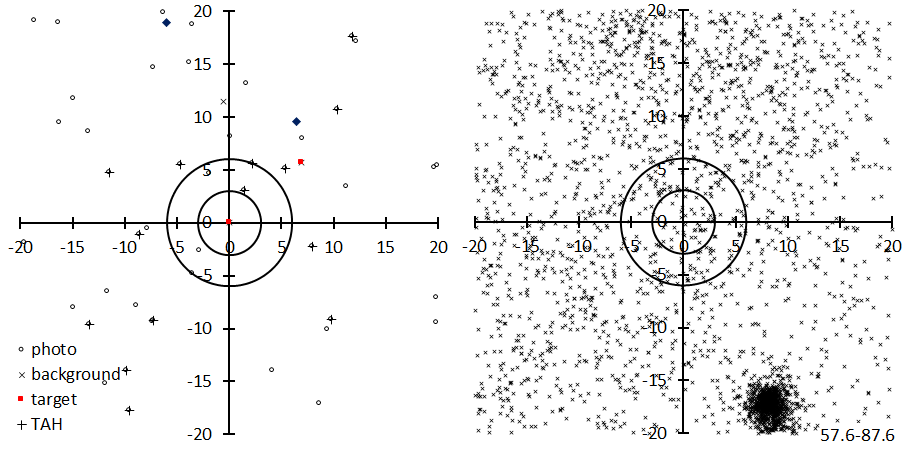
Figure 4 – Radiant point distribution around TAH. IAU MDCSD and photo observation (left), GMN (right).
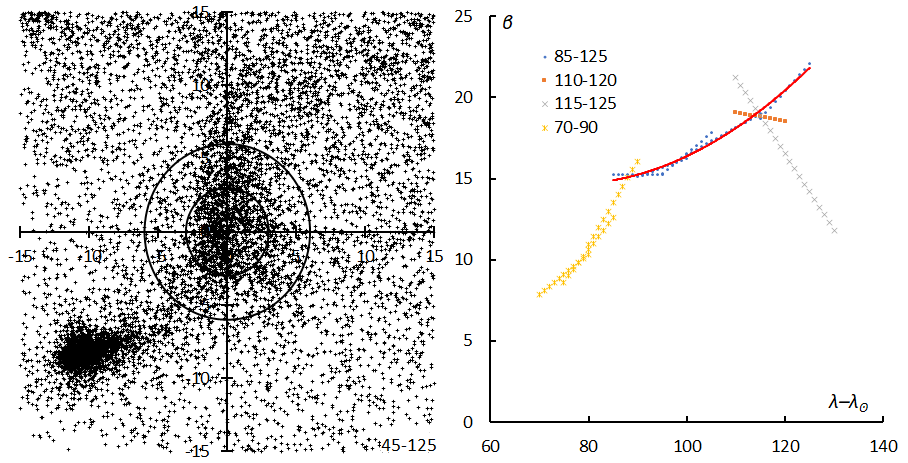
Figure 5 – Water flowing from the water bottle to the fishes: radiant point movement of “PPS” by GMN (left). Estimated ecliptic latitude of the radiant point for every 10 degrees of solar longitude (right).
4 0372PPS and neighbor activities
The radiant point distribution for the period λʘ = 45° to 125° centered at (λ–λʘ, β) = (282.4°, 16.4°) is shown in Figure 5 (left). The center is PPS (phi-Piscids) and the bottom left is ETA (eta-Aquariids). It is as if there is activity extending upward from ETA through PPS. There is an existence called “the tail of Orionids” (Jenniskens et al., 2016a) and it can also be compared to water flowing from an aquarium to fishes (as a constellation, water flowing out of Aquarius flows into the mouth of Piscis Austrinus). The question of how much of this flow should be considered as PPS activity is complicated, similar to the question of how to demarcate the activities within the “the tail of Orionids”.
If the radiant point at λʘ = 85° is (λ–λʘ, β) = (285°, 13°), find the movement of the radiant point so that the regression line converges as in the case of other meteor showers. This operation was repeated with the next radiant point located 5 degrees before and after the solar longitude.
The results for the ecliptic latitude of the radiant point are shown in Figure 5 (right). The activity with λʘ < 85° appears to be different from the activity that precedes it. How this activity with λʘ < 85° is related to ETA remains a future issue. Even when λʘ > 85°, the movement of the radiant point (the line from λʘ = 110° to 120°) calculated around λʘ = 115° is heterogeneous. If we investigate the movement of the radiant point for λʘ = 115°~125° with
(λ–λʘ, β) = (279.0°, 16.0°) as the center, we can find the movement indicated by plusses in the figure for λʘ = 115°~125° (in the figure, this result is extrapolated 5 degrees forward and backward). The radiant point distribution spreading from the center to the lower right in Figure 5 (left) corresponds to this movement. In this paper, this is called PPS_1, and the period excluding this period, shown by the red curve in Figure 5 (right), is called PPS_0.
5 0165SZC and 0370MIC
In the current IAU MDCSD, what should be classified as 0370MIC (Microscopiids) is placed in 0165SZC (Southern June Aquilids). As shown in Table 3, 0165SZC00, 01 is completely different from the reports below. It is clear that 165SZC02 and below are the same activities as 0370MIC00. This is thought to be because the degree of attention differs depending on whether the shower status flag (s) is 1 (established shower) or 0 (working list). 0370MIC00 was reported in 2010, and subsequent reports below 0165SZC02 should be included in 0370MIC.
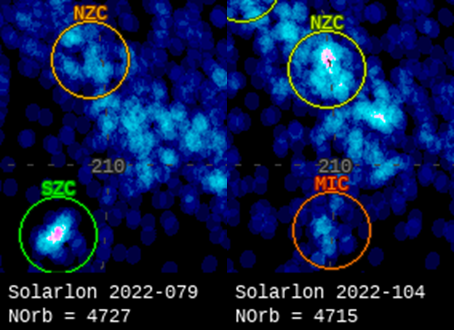
Figure 6 – SZC (left) and MIC (right) in CMOR observation.
Table 3 – Confusion between SZC and MIC in IAUMDCSD.
| Code | s | α | δ | vg | λʘ | λ–λʘ | β | References |
| 0165SZC00 | 1 | 304.8 | -33.92 | 33.17 | 79.7 | 219.5 | -13.94 | 1] Gartrell & Elford, 1975 |
| 0165SZC01 | 1 | 304.7 | -32.8 | 38.6 | 80.5 | 218.89 | -12.83 | 2] Brown et al., 2008 |
| 0165SZC02 | 1 | 319.3 | -27.6 | 39.2 | 104 | 209.24 | -11.26 | 3] Jenniskens et al., 2016 |
| 0165SZC04 | 1 | 320.4 | -26.5 | 39.9 | 106.5 | 208.03 | -10.51 | 5) Shiba, 2022 |
| 0370MIC00 | 0 | 320.3 | -28.3 | 38 | 104 | 209.87 | -12.2 | 1] Brown et al., 2010 |
Both 0165SZC01 and 0370MIC00 were observed by CMOR, and even now, the CMOR image clearly shows that SZC is a completely different meteor shower from MIC (Figure 6 (left)). Note that the activity near the original SZC, λʘ = 80°, was short-lived, and only a few meteors were captured by video observations. Probably SZC has many faint meteors. Conversely, MIC is clearly captured in video observations, but not so clearly in CMOR observations (Figure 6 (right)).
In GMN, MIC’s activities are referred to as SZC, and does neither appear in SonotaCo net’s J14 list.
6 0012KCG and neighbor activities: 0012KCG, AXD, 0073ZDR and 0197AUD
There is considerable confusion about the meteor showers in and around KCG (kappa-Cygnids). First of all, it is important to note that KCG is active on an approximately 7-year cycle, and its activity is rarely seen in normal years. The AXD (August xi Draconids: this is the author’s tentative name because nothing corresponding to IAU MDCSD has been observed) is located several degrees west of KCG and shows weak activity every year. In GMN observations, there are more AXD than KCG, except in 2021, when KCG was active. Figure 7 will be explained in detail later, but of the two radiant point groups seen in both figures, the left one is KCG and the right one is AXD. In the current IAU MDCSD, KCG reports are inconsistent due to confusion with AXD.
The second thing that has caused confusion is that the IAU MDC has been misclassifying ZDR (zeta-Draconids) and AUD (August Draconids). ZDR and AUD are listed as shown in Table 4 now. However, the Jenniskens meteor shower table (Jenniskens, 2006), which is the prototype of IAU MDC, covers slightly different material. In this earliest meteor shower table, L1-167 and S3-142 in Table 5 were listed as ZDR observations, and both S3-147 and S3-149 were listed as AUD.
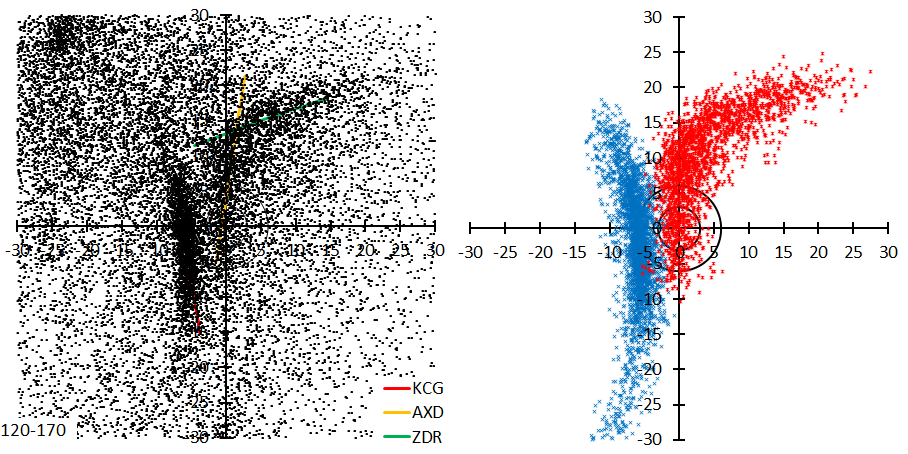
Figure 7 – KCG and AXD. Among the radiant points at left, only the radiant points are picked out which were classified by GMN as KCG (in blue) or AUD (in red) at right.
Table 4 – Meteor showers listed as ZDR or AUD in IAU MDCSD.
| Code | s | α | δ | vg | λʘ | λ–λʘ | β | References |
| 0073ZDR00 | 0 | 261.7 | 67.8 | 22.36 | 122 | 33.15 | 86.55 | 1] Molau & Rendtel, 2009 |
| 0197AUD00 | 1 | 272.45 | 64.91 | 17.3 | 141.9 | 160.51 | 88.06 | 1] Sekanina, 1976 |
| 0197AUD01 | 1 | 271.7 | 58.9 | 21.1 | 143 | 133.57 | 82.3 | 2] Jenniskens et al., 2016 |
| 0197AUD03 | 1 | 21 | 149 | 4) Shiba, 2022 |
Table 5 – Confusion in ZDR and AUD. For the source, see Koseki (2009).
| Source | α | δ | vg | λʘ | λ–λʘ | β | Shower |
| L1-167 | 260 | 30 | 18 | 135 | 120.6 | 52.9 | θ-Herculids |
| S3-142 | 303.2 | 42.7 | 17 | 139.7 | 184.1 | 60.1 | Gamma-Cygnids |
| T1-110 | 270.7 | 54.1 | 21.9 | 148.4 | 123.4 | 77.5 | ζ-Drads |
| L1-207 | 269 | 59 | 24 | 149.5 | 116.6 | 82.4 | ζ-Draconids |
| S3-147 | 271.3 | 65 | 23.6 | 140.8 | 148.7 | 88.4 | August Draconids |
| S3-149 | 272.4 | 64.9 | 17.3 | 141.2 | 160.6 | 88.1 | φ-Draconids |
| Denning | 260.5 | 63.3 | ζ-Draconids |
Table 6 – Definition of KCG and AUD by GMN.
| Code | λʘmin | λʘref | λʘmax | λ–λʘ | D(λ–λʘ) | b | Db | vg | Dvg |
| KCG_1 | 93.1 | 113.6 | 125 | 157.943 | -0.21 | 46.628 | 0.846 | 18.511 | 0.039 |
| KCG_2 | 125 | 140.1 | 150 | 162.943 | 0.733 | 70.573 | 0.634 | 22.312 | 0.202 |
| KCG_3 | 150 | 154.7 | 167.1 | 187.379 | 3.3 | 78.47 | 0.219 | 25.638 | 0.264 |
| AUD_1 | 130.7 | 142.7 | 148 | 144.446 | -0.468 | 79.238 | 0.881 | 21.114 | 0.184 |
| AUD_2 | 148 | 153.5 | 164.9 | 57.173 | -2.675 | 81.706 | -0.885 | 21.142 | -0.199 |
The scope of ZDR in the earliest table is ambiguous (L1-167 and S3-142 in Table 5), and the current IAU MDCSD ZDR is far from them. The existence of the latter cannot be confirmed at all in past photographic observations or modern video observations. However, there are photographic observations (T1-110 and L1-207 in Table 5) that can be identified as ζ-Draconids that appear in the classic Denning meteor shower table (Denning, 1899). Had the IAU MDCSD adopted either of these studies, the situation would have been different.
S3-147 and S3-149 in Table 5, which are listed as AUD in the earliest tables, are both from Harvard radio observations, and the radiant points are almost the same, with only a slight difference in geocentric velocity. It is unclear why IAU MDSD did not adopt S3-147 (August Draconids), which is the origin of the name AUD. In addition, the radiant points of the current IAU MDC AUD00 (S3-149) and AUD01 listed above are several degrees apart, and there is also a difference in geocentric velocity, so there are some doubts about their identification.
In addition to the confusion of IAU MDC, there is also the problem of the shape of the radiant point distribution, as seen in Figure 7. Figure 7 plots all the radiant points observed by GMN during the period λʘ = 120° to 170°, centered on (λ–λʘ, β) = (145°, 75°). The two radiant point distributions are each curved. Figure 7 (right) shows only the meteors classified to be KCG or AUD by GMN.
Table 6 quotes how GMN represents KCG and AUD, and GMN divides KCG into three parts and AUD into two parts. λʘmin and λʘmax indicate the lower and upper limits of the respective periods. λʘref is the representative value for each period, and the values of λ–λʘ, β, and vg correspond to it. Δ(λ–λʘ), Δβ and Δvg indicates the amount of change depending on the solar longitude.
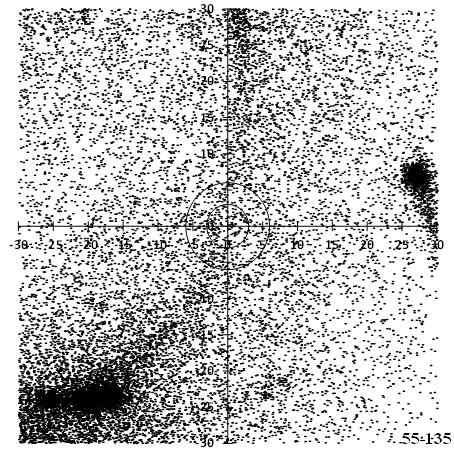
Figure 8 – Radiant arcs extending south of KCG.
As for the curve of this radiant point distribution, interestingly, a series of radiant points can be traced even before λʘ = 93.1°, which GMN considers to be the start of KCG activity, as shown in Figure 8. Figure 8 shows the radiant distribution for the period from λʘ = 55° to 135°, centering on (λ–λʘ, β) = (160°, 35°). The radiant points at the top center of the figure represent the early activity of KCG. The radiant density distribution decreases towards the center of the figure, but it appears to extend further down to the ecliptic showers (0456MPS, 0150SOP).
One idea is to set multiple definitions for a single meteor shower like GMN, but on the other hand, it is also possible to break them down into independent activities. In this paper, we will not discuss KCG_1 and KCG_3 proposed by GMN as future issues. In addition, AUD_1 and AUD_2 are divided into two meteor showers, AXD and ZDR, respectively. This classification into AXD and ZDR follows the previous meteor shower table based on SonotaCo net data and the analysis using EDMOND data (Koseki, 2020).
Neither AUD nor ZDR is featured in SonotaCo net’s J14 list. It should also be noted that the definition of KCG is different between the J5 list which was applied to the orbit catalogue until 2020 and the J14 list (KCG_ja) in the SonotaCo net shower table, as shown in Figure 9.
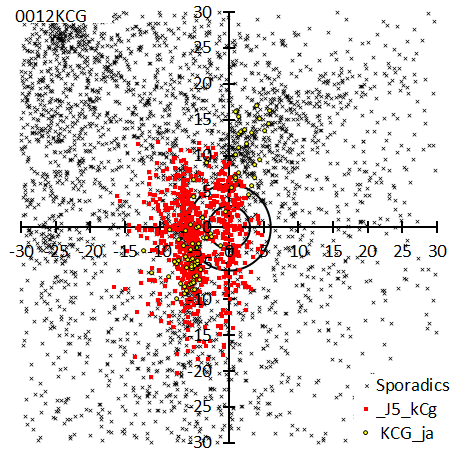
Figure 9 – Changes in the definition of KCG in SonotaCo net.
7 0033NIA and 0215NPI
NIA stands for “Northern iota-Aquariids”, while NPI stands for Northern delta-Piscids. Although this paper assumes that NIA and NPI should be unified, the two are often separated, including in the IAU MDCSD. It is necessary to explain the cause of this confusion.
The “Northern ι-Aquariids” came to attract attention due to research by Wright et al. (1957) using Harvard photographic observations. They linked the detected meteor activity to the ι-Aquariids reported by McIntosh (McIntosh, 1935) in New Zealand. It has been thought that the northern branch of the ι-Aquariids (also the southern branch) is active from late July to early August, almost the same period as the group of the δ-Aquariids. The early radio observations by Ellyett & Roth (1955) cited by Wright et al. (1957) were also from late July to early August. It is true that Wright et al.’s observations also include meteors in the range of λʘ > 145°, but they should be distinguished from “original ι-Aquariids”. Table 7 shows the entries reported to be part of the ““Northern ι-Aquariids” based on observations in the 20th century, and the top three correspond to “original ι-Aquariids”. The bottom three seem to have been named after the “original ι-Aquariids” even though NPI has been observed.
The NIA section of the IAU MDCSD contains a mixture of reports that were influenced by the “original ι-Aquariids” and reports that actually refer to NPI activities. Table 8 shows all NIA and NPI reports listed in the IAU MDCSD.
It is thought that NIA00, 01, and 04 were attempts to observe this “original ι-Aquariids”. The remaining NIA02, 03, 05, and 07 are reports after NPI00-02, and should be included in NPI.
Both GMN and SonotaCo Net have confusion in their treatment of NIA and NPI, and both treat them as separate groups. However, as shown in Table 9, the estimated value from the radiant shift that combines NIA and NPI in this paper (shown as NIA + NPI) sufficiently represents the radiant points of both, and NIA and NPI should be treated as one activity.
Table 7 – Various “Northern ι-Aquariids”. For No., see Koseki (2009).
| No. | α | δ | vg | λ–λʘ | β | e | q | i | ω | Ω | λʘ | Stream |
| LE-313 | 326.1 | -3.4 | 39 | 208.8 | 9.7 | 0.94 | 0.1 | 28.9 | 328.8 | 118.3 | 118.3 | Northern i-Aquariids? |
| K1-91 | 321.7 | -7.8 | 35 | 200.8 | 6.9 | 0.89 | 0.2 | 12 | 313 | 120.7 | 120.7 | N i-Aquariids |
| NI-61.7.11 | 326.9 | -12.1 | 30 | 199 | 1.2 | 0.85 | 0.234 | 6.9 | 312.5 | 126 | 126 | N.i-Aquariids? |
| S2-50 | 352.5 | -0.8 | 28.2 | 200.6 | 2.2 | 0.823 | 0.242 | 3.2 | 313.5 | 152.2 | 152.2 | Northern i-Aquariids |
| S3-159 | 350.1 | 0.6 | 26.1 | 198.1 | 4.4 | 0.777 | 0.302 | 5.2 | 307.4 | 153.1 | 153.1 | Northern i-Aquariids |
| LI-78 | 354.6 | 1.3 | 31 | 193.5 | 3.3 | 0.83 | 0.326 | 4 | 299.7 | 162.1 | 162.1 | Northern i Aquariids |
Table 8 – All entries of NIA and NPI in the IAU MDCSD; “ot” means observation technique.
| Code | s | a | d | vg | λʘ | λ–λʘ | b | Notes | ot | References |
| 0033NIA00 | 1 | 327.66 | -5.88 | 31.2 | 147.7 | 180.11 | 6.76 | *1 | 1] Cook, 1973 | |
| 0033NIA01 | -2 | 328 | -4.7 | 27.6 | 145.1 | 183.44 | 7.75 | *1 | 2] DMS 2001 | |
| 0033NIA02 | 1 | 356 | 3 | 28.6 | 159.5 | 198.02 | 4.34 | *1 | R | 3] Brown et al., 2008 |
| 0033NIA03 | 1 | 355.4 | 3.4 | 28.7 | 159 | 198.13 | 4.95 | *1 | R | 4] Brown et al., 2010 |
| 0033NIA04 | 1 | 334 | -8.3 | 27.19 | 142 | 190.89 | 2.3 | *1 | T | 5] Molau et al., 2012 |
| 0033NIA05 | 1 | 346.7 | -1.2 | 31.3 | 148 | 199.3 | 4.14 | *1 | T | 6] Jenniskens et al., 2016 |
| 0033NIA07 | 1 | 2.3 | 4.9 | 29.7 | 166.9 | 197.16 | 3.58 | T | 8) Shiba, 2022 | |
| 0215NPI00 | 2 | 0.84 | 3.74 | 27.4 | 168.3 | 193.96 | 3.1 | *2 | R | 1] Sekanina, 1973 |
| 0215NPI01 | 2 | 9.15 | 7.04 | 25.6 | 173.5 | 197.67 | 2.85 | *3 | R | 2] Sekanina, 1976 |
| 0215NPI02 | 2 | 7.64 | 7.14 | 30.4 | 173.3 | 196.54 | 3.53 | *4 | P | 3] Porubcan & Gavajdova, 1994 |
| 0215NPI03 | -7 | 9.2 | 7.7 | 31.2 | 174.4 | 197.08 | 3.43 | *5 | 4] Jenniskens, 2006 | |
| 0215NPI04 | 2 | 10.2 | 8.6 | 28 | 176 | 196.75 | 3.87 | *6 | T | 5] Jenniskens et al., 2010 |
| 0298IAQ00 | -2 | *7 | 1] Jenniskens, 2006 |
Notes:
*1: Member of 298/IAQ complex
*2; In Sekanina 1973, the shower name is Piscids (p. 257 & 260), member of 030/PSC
*3: In Sekanina 1976, the shower name is Piscids (Tab. VI, p. 285) , Member of 030/PSC
*4: In Porubcan & Gavajdova 1994, the shower name is delta-Piscids , Member of 030/PSC
*5: No original reference, member of 30/PSC
*6: ? Encke complex, member of 30/PSC
*7: Group members: 33/NUA, 3/SIA; removed, empty record; NUA is a misprint of NIA.
Table 9 – Comparison of SonotaCo Net’s J14 list, GMN’s list, and this article’s estimated value obtained by unifying NIA and NPI.
| Code | Source | λʘ | λ–λʘ | b | a | d |
| NIA | GMN | 162.6 | 197.19 | 3.893 | ||
| NIA+NPI | 163 | 197.5 | 3.8 | 359 | 3.7 | |
| SonotaCo | 151.8634 | 350.535 | -2.48922 | |||
| NIA+NPI | 152 | 199.6 | 3.9 | 350.8 | 0.2 | |
| NPI | GMN | 183.6 | 191.771 | 3.655 | ||
| SonotaCo | 182.1232 | 12.66271 | 9.177 | |||
| NIA+NPI | 183 | 193.7 | 3.8 | 14 | 10.1 |
8 The tail of Orionids
Figure 10 shows the radiant point distribution observed during the period from λʘ = 130° to 240°, with (λ–λʘ, β) = (254°, –17°) as the center and reveals unique meteor activity series: the tail of Orionids (Jenniskens et al. 2016a). On the left is GMN’s video observation, and on the right is the distribution of meteor showers registered with the IAU MDCSD. Table 10 gives the radiant points of the distribution map in Figure 10 (right).
The underlined showers are referred to as “The Halley Complex” in the IAU MDCSD. Although not shown in this table, 0719LGM00 (λʘ = 232°, λ–λʘ = 234.06°, β = –5.01°) is also included in this group. RER and PSO look like forked tails.
There is no general standard as to what is considered an independent activity. In addition to ORI, this article covers ERI, PSO, and NUE, which are rated 8 or higher on a 10-point scale in our previous research (Koseki, 2023c).
A band of weak radiant points can be seen to the right of “the tail of Orionids”. 0194UCE00, 0583TTA00, and 1142SNT00 correspond to this. Figure 11 represents the radiant point distribution and activity curve based on TTA taking the radiant shift into account. Although the radiant distribution looks like a single meteor shower, the activity profile suggests multiple activities. Even if this band of radiant points has some common origin, it would take some discussion to recognize it as a single meteor shower. It is interesting that there are other bands of radiant points besides the “tail of Orionids”. There are several other examples where “tails” or “bands” are similarly observed, so please refer to those as well, see: Section 4 “0372PPS and neighbor activities”, Section 6 “0012KCG and neighbor activities: 0012KCG, AXD, 0073ZDR and 0197AUD”, Section 12, “0338OER and 0490DGE”.
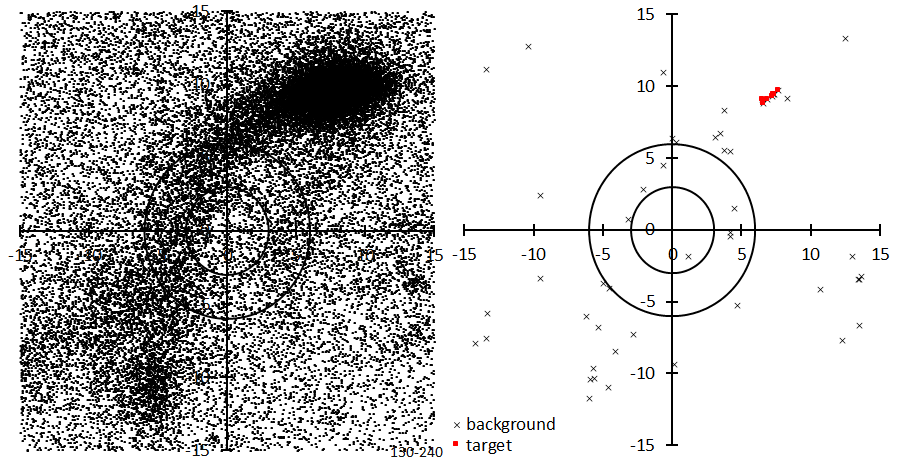
Figure 10 – The tail of the Orionids during the period λʘ = 130°~240°, centered at (λ–λʘ, β) = (254°, –17°). GMN video observations (left), the IAU MDCSD (right).
Table 10 – Radiants around the tail of Orionids in the IAU MDCSD plotted in Figure 10 (right).
| Code | λʘ | x | y | Code | λʘ | x | y | Code | λʘ | x | y |
| 0466AOC01 | 136.8 | 3.47 | 6.69 | 1087OOE00 | 167.3 | 4.69 | -5.25 | 0718XGM00 | 206 | 3.1 | 6.4 |
| 0191ERI02 | 137 | -5.59 | -10.37 | 0337NUE00 | 167.9 | -4.92 | -3.74 | 1198XRO00 | 207.1 | 8.3 | 9.11 |
| 0535THC00 | 137 | 12.98 | -1.86 | 0337NUE02 | 168.6 | -4.51 | -4.07 | 0008ORI03 | 207.5 | 6.89 | 9.04 |
| 0738RER00 | 137 | -9.48 | -3.36 | 1142SNT00 | 171.2 | 4.47 | 1.47 | 0008ORI04 | 207.9 | 6.52 | 9.07 |
| 0191ERI00 | 137.5 | -5.97 | -11.75 | 0595TTT00 | 175 | 12.5 | 13.33 | 0008ORI05 | 208 | 6.6 | 8.77 |
| 0191ERI01 | 137.6 | -5.87 | -10.45 | 0430POR00 | 178.4 | -2.09 | 2.8 | 0008ORI01 | 208.6 | 7.33 | 9.45 |
| 0466AOC02 | 138 | 4.24 | 5.46 | 0896OTA00 | 179.3 | -13.37 | 11.14 | 0008ORI00 | 208.7 | 7.41 | 9.43 |
| 0466AOC00 | 138.5 | 3.74 | 5.53 | 0211AOR00 | 182.8 | -9.51 | 2.38 | 0008ORI06 | 209 | 7.24 | 9.27 |
| 0194UCE00 | 145.7 | 4.22 | -0.17 | 0876ROR00 | 185.3 | 1.15 | -1.87 | 0008ORI02 | 209.8 | 7.68 | 9.67 |
| 0193ZAR00 | 146.7 | -10.39 | 12.73 | 0479SOO00 | 185.6 | 0.34 | 6.06 | 0232BCN00 | 214 | -4.63 | -10.97 |
| 0873OMI00 | 152.8 | 10.71 | -4.18 | 0479SOO01 | 185.7 | -0.62 | 4.49 | 0558TSM00 | 221 | -5.7 | -9.66 |
| 0552PSO01 | 159 | -14.17 | -7.94 | 0225SOR01 | 187 | -6.2 | -6.04 | 0243ZCN00 | 225 | -0.64 | 10.94 |
| 0337NUE03 | 163 | -3.16 | 0.72 | 0479SOO02 | 187 | 0.04 | 6.35 | 0558TSM01 | 227 | -4.06 | -8.46 |
| 0583TTA00 | 164 | 4.19 | -0.44 | 0225SOR00 | 191.7 | 0.14 | -9.38 | 0245NHD00 | 234.8 | -5.32 | -6.81 |
| 0337NUE01 | 165 | -13.36 | -5.8 | 0226ZTA01 | 196 | 3.79 | 8.28 | 0246AMO00 | 239 | 13.48 | -3.43 |
| 0552PSO00 | 166.3 | -13.42 | -7.6 | 1090EOR00 | 196.5 | 12.29 | -7.69 | 0246AMO01 | 239.3 | 13.44 | -3.47 |
| 1088SEE00 | 166.5 | 13.51 | -6.67 | 0227OMO00 | 206 | -2.81 | -7.33 | 1196ZCM00 | 239.8 | 13.64 | -3.28 |
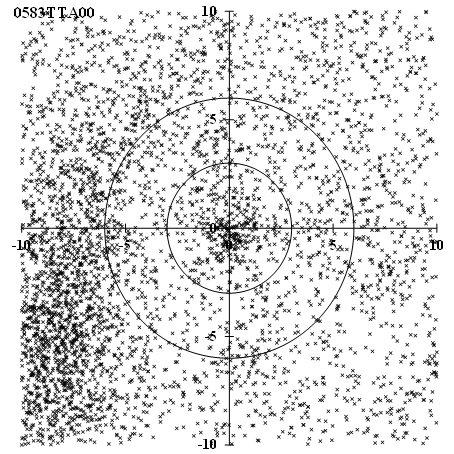
Figure 11 – Third tail of Orionids? The radiant point distribution using 0583TTA00 data taking the radiant drift into account.
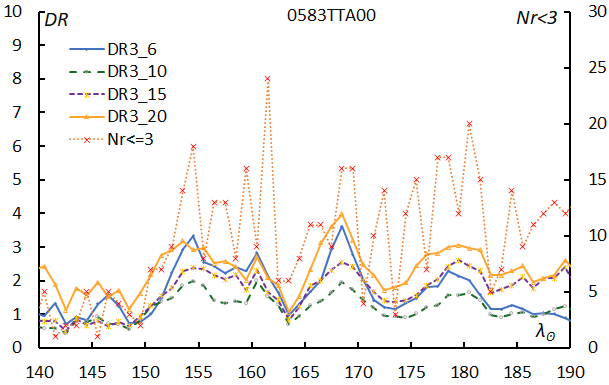
Figure 12 – The activity profile of the “third tail of the Orionids” plotted in Figure 11.
9 0081SLY00 and 0081SLY01
The confusion began when 0081SLY was considered a single activity by the same observer (Molau and Rendtel, 2009). In Figure 13 (left), the upper left of the 6-degree circle is SLY00, and symmetrically, the group of spread radiants at the lower right of the circle is SLY01. Not only are they more than 10 degrees apart in position, but there is also a 20-degree difference in solar longitude. For this reason, SLY is on the working status, and as a result, the IAU MDCSD has given each of the two SLYs different numbers and names: 0705UYL00 = SLY00 and 0424SOL00 = SLY01. 0425PSA01 and 0613TLY00 may also be included in the SLY01 activity.
Lindblad’s “Lyncids” (Lindblad, 1971), which corresponds to SLY01, is used as 0081SLY in the Jenniskens meteor shower table (Jenniskens, 2006) , which is the prototype of IAUMDC. Molau and Rendtel (2009). probably detected SLY01 as a counterpart to this observation and found SLY00 as another candidate. In Figure 13 (right), triangles are meteor showers that are not listed in the IAU MDCSD, and the filled triangle are the “Lyncids”. Among the circles in the photographic observations, two meteors that Lindblad identified as belonging to the “Lyncids” are indicated by filled circles.
SonotaCo net’s J14 list takes UYL, but not SLY01. GMN treats SLY01 as SOL. In this paper, SLY00 will be referred to as SLY_0 and SLY01 will be referred to as SLY_1.
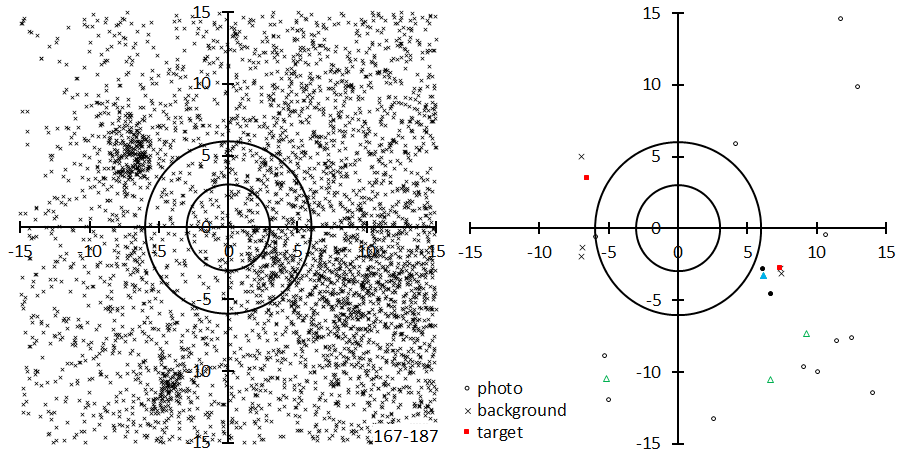
Figure 13 – Two SLYs during the period λʘ = 167°~187° centered at (λ–λʘ, β) = (287°, 29°). Video observations of GMN (left), Photographic observations and the IAU MDCSD (right).
10 0480TCA and 0481OML
Contrary to SLY, confusion arose because the same observer (Rudawska and Jenniskens, 2014) separated 0480TCA and 0481OML into two separate activities, in this case. Both TCA and OML are meteor showers detected by combining SonotaCo net and CAMS data. Figure 14 shows the radiant distribution for the period λʘ = 192°~232° centered on (λ–λʘ, β) = (283°, 14°), and as can be seen, the two activities are continuous. The radiant point on the lower right is due to early Leonid activity.
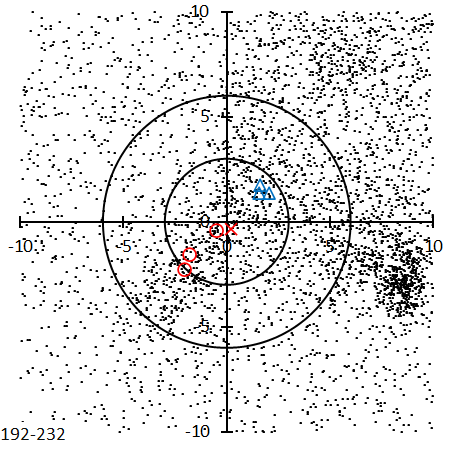
Figure 14 – TCA and OML; small dash: GMN video observations, circle: TCA, triangle: OML, cross: SGC.
Both TCA and OML are on the working status in the IAU MDCSD, and a new meteor shower called 1114SGC (sigma1-Cancrids) has been added to the IAU MDCSD, which corresponds to TCA.
In GMN, the name OML is not used, and the activities at λʘ = 178.5°~221.9° are referred to as TCA. SonotaCo net’s J14 list features both TCA (λʘ = 200.6°~208.1°) and OML (λʘ = 216.8°~221.5°).
11 The subdivisions of 0002STA and 0017NTA
STA
IAUMDCSD annotates the following seven reports as “#2/STA component”: 0286FTA00、0625LTA00、0626LCT00、0627NPS00、0628STS00、0636MTA00、0637FTR00. In addition to this, 0624XAR00 is also considered part of STA. The SonotaCo net J14 list does not treat it as an independent activity and sets a long activity period of λʘ = 181.57°~267.40°. On the other hand, while GMN considers the above eight activities as activities independent of STA, it also treats STA activities during a period of λʘ = 190° to 230° (see Figure 16 (left)).
As the author has argued many times, it is appropriate to think of STA in two parts (Koseki, 2012, 2020). Just as Whipple divided the activity into October Arietids and Taurids in November (Whipple, 1940), it was also known from visual observations that the main maximum occurs in November after the less active maximum in October. Figure 15 represents the radiant points in the range of λ–λʘ = 180°~205° and β = –8~–2 during the period of λʘ = 185°~245°. As in the previous paper (Koseki, 2021), the group shown by the straight line is called STA_SE, and the group shown by the broken line is called STA_SF. STA_SE corresponds to October Arietids, and STA_SF corresponds to Taurids in November. STA_SF shows significant activity in the years for which David Asher noted that the Taurids activity intensifies (Asher and Clube, 1993), but STA_SE shows no change. These two activities must be considered separately because they show clear differences in the magnitude ratio and the beginning height of the meteor path (Koseki, 2023a).
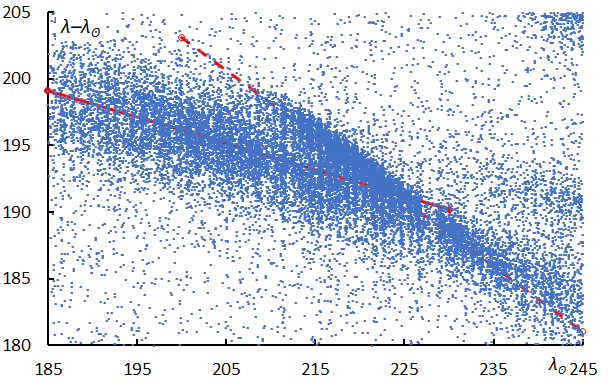
Figure 15 – The distribution of radiants in the range of λ–λʘ = 180° ~ 205° and β = −8~−2, during λʘ = 185°~245°.
NTA
Similar to STA, there are eight reports in NTA with the annotation “#17/NTA component”: 0629ATS00, 0630TAR00, 0631DAT00, 0632NET00, 0633PTS00, 0634TAT00, 0635ATU00, 0726DEG00. Even in this case, the SonotaCo net J14 list lumps together the activities with λʘ = 199.69°~276.42°, but while GMN treats the eight activities independently, it also monitors the activities of NTA during λʘ = 217°~ 241° (see Figure 16 (right)).

Figure 16 – Observed numbers classified as STA (left) and NTA (right). The true activities of STA and NTA cannot be represented because of the segmenting of their respective activities.
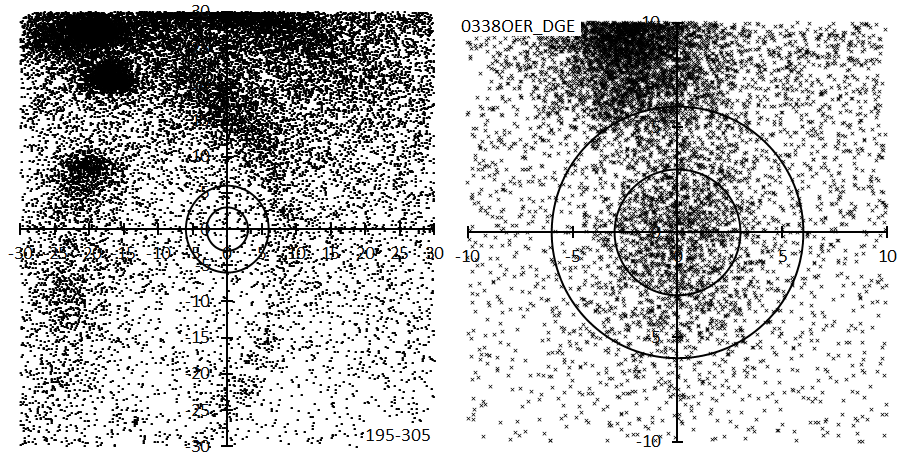
Figure 17 – Radiant arc extending from OER. The radiant distribution for the period from λʘ = 195° to 305°, centered at
(λ–λʘ, β) = (185°, –37°) (left). Distribution of radiant points with λʘ = 195°~305° accumulated along the radiant arc (right).
Table 11 – The IAU MDCSD meteor showers existing within the range of Figure 17 (left).
| Code | λʘ | λ–λʘ | b | vg | Distance | Angle | x | y |
| 0002STA05 | 196 | 195.6 | -4.2 | 28.2 | 5.89 | 7 | -0.69 | 5.85 |
| 0028SOA01 | 196 | 196.8 | -4.2 | 29 | 6.14 | 18 | -1.86 | 5.85 |
| 0002STA03 | 196.5 | 195.2 | -4.3 | 27.92 | 6.07 | 3 | -0.37 | 6.06 |
| 0028SOA00 | 198.5 | 195.8 | -2.8 | 25.6 | 8.94 | 9 | -1.46 | 8.82 |
| 0902DCT00 | 202.1 | 194.4 | -13.2 | 32.7 | 0.96 | 79 | -0.94 | 0.19 |
| 0002STA09 | 202.4 | 195.2 | -4.6 | 28.6 | 9.1 | 12 | -1.86 | 8.91 |
| 0624XAR00 | 205 | 195.1 | -4.6 | 28.5 | 10.18 | 13 | -2.32 | 9.92 |
| 0086OGC00 | 206.7 | 199.2 | -24.5 | 3.3 | 11.5 | 147 | -6.34 | -9.6 |
| 0338OER03 | 230.5 | 184.6 | -20.8 | 28 | 1.5 | 190 | 0.25 | -1.48 |
| 0338OER01 | 232 | 185.7 | -20 | 28.5 | 1.33 | 105 | -1.28 | -0.33 |
| 0338OER00 | 234.7 | 183.5 | -21.8 | 26.9 | 1.33 | 175 | -0.11 | -1.32 |
| 1115NXE00 | 241.88 | 180.7 | -24.5 | 26.06 | 1.42 | 183 | 0.08 | -1.42 |
| 0490DGE00 | 249.3 | 176.1 | -35.3 | 23.8 | 8.67 | 192 | 1.79 | -8.48 |
| 0490DGE01 | 254 | 176.8 | -29.9 | 24.7 | 0.1 | 178 | 0 | -0.1 |
| 0709LCM01 | 273.3 | 175.1 | -45.9 | 25.1 | 0.47 | 105 | -0.46 | -0.12 |
| 0709LCM00 | 286 | 176.4 | -54.6 | 25.4 | 2.46 | 329 | 1.27 | 2.11 |
| 0308PIP00 | 290.7 | 198.8 | -63.3 | 33 | 8.68 | 120 | -7.51 | -4.35 |
12 0338OER and 0490DGE
OER has already been set as an established shower, but OER03 has been marked with “Continue to (#490 DGE) December delta Eridanids.” It certainly looks like that, but in fact, meteor activity that is expected to continue ahead of it has also been captured. Figure 17 (left) shows the radiant distribution for the period from λʘ = 195° to 305°, with (λ–λʘ, β) = (185°, –37°) as the center. Although it is for such a long period, the radiant points are connected in an arc shape. The radiant cluster at the top of the figure is the STA, and the OER starts its activity hanging from here.
Figure 17 (right) shows the integrated radiant distribution if the radiants move along this arc. Many IAU MDCSD meteor showers exist within the range of this figure, as shown in Table 11. Among these, the codes for those within 3 degrees from the center are shown in red. Instead of DGE00 being removed, the activity 0709LCM is included.
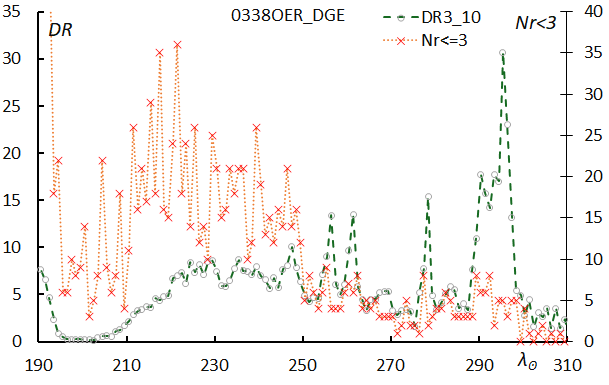
Figure 18 – The number of meteors within 3 degrees.
Furthermore, GMN describes the activities after DGE as 0308PIP, but the descriptions from 0300ZPU00 to 0318MVE00 are fragmentary visual observation reports compiled by Jenniskens from his perspective (Jenniskens, 2006). It would be unreasonable to think of 0308PIP as an extension of all activities after DGE.
Similarly, if we count the number of meteors and draw an activity profile along the arc, we get Figure 18. If we look at the graph of the number of meteors Nr <= 3 within 3 degrees from the center, it seems that the activity is at its maximum around λʘ = 230°, but when looking at DR3_10, the maximum is around λʘ = 295°. Considering that the position of the radiant has moved considerably south and the number of meteors detected from the Northern Hemisphere will decrease, it is impossible to judge changes in activity simply by the number of meteors. On the other hand, during the first half of these meteor shower activities, there were strong activities such as not only STA but also MON and GEM, so caution is required when considering changes in DR. The reason that DR3_10 decreases when λʘ < 220° is due to the influence of STA, and when DR3_20 is used, the influence of GEM becomes strong around λʘ = 260°. Considering these constraints, this arc-like continuous activity can be thought of as a single activity or as a combination of multiple activities. If we calculate the changes in the orbit by linking the arc-shaped activity, it appears that the perihelion direction and semi-major axis of the orbit remain fairly constant. Problems remain unsolved as into how many parts it will be divided, and whether it can be considered as a whole. As mentioned above it is currently unclear what the later stage of the activity was when the radiant point moved deep to the south, so future GMN activity in the southern hemisphere is expected.
GMN treats OER and DGE as one, but the SonotaCo Net J14 list only covers OER and does not mention DGE. GMN considers the activity to extend up to λʘ = 260.5°, but around this time the radiant distribution has entered the part where it moves southward in an arc shape.
13 0340TPY00 and 0340TPY01
The IAU MDCSD has three reports for 0340TPY. The first one is from SonotaCo net in 2009, and the latter two are both from CAMS’s first report (Jenniskens et al, 2016b). Figure 19 shows the radiant distribution for the period from λʘ = 240° to 270°, centering on (λ–λʘ, β) = (260°, –35°). Of the two TPYs, the upper one is TPY01 and 02, and the lower one is TPY00. Although the difference in position is not so large, the confusion started because the IAU MDC accepted the CAMS report as TPY01 even though they are about 15 degrees apart in solar longitude. Because of the difference between TPY00 and TPY01, they were set as working status each, so a duplicate report of “a new meteor shower” was registered.
In the J14 list of SonotaCo net, TPY00 is just TPY and TPY01 and 02 are DMH. However, in GMN, TPY00 is treated as DTP, and the pair of TPY01 and 02 is treated as TPY. Since TPY00 is reported earlier than TPY01 and 02 and before DTP, it is appropriate to use TPY00 as TPY like SonotaCo net.
In addition, in the previous paper (Koseki, 2021), these two activities were distinguished as TPY_0 and TPY_3, but since TPY03 was deleted from the IAU MDCSD, TPY_0 will remain as it is, and what used to be called TPY_3 will be referred to as TPY_1 in this paper. A new report of TPY is registered in IAUMDCSD as TPY04 that is TPY_0.
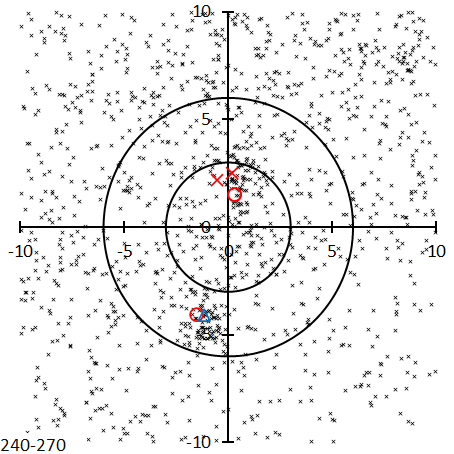
Figure 19 – Two TPYs. GMN video observations with the IAU MDCSD showers.
14 0096NCC and 0097SCC
Figure 20 shows the radiant point distribution for every 10 degrees in solar longitude between λʘ = 235° and 315°, centering on (λ–λʘ, β) = (190°, 0°). The radiant distribution shows that while the radiant points of STA and NTA are moving to the right on the diagram, what appears to be a collection of radiant points remains near the center. Discussion is still ongoing as to whether these activities should be collectively called NCC or SCC, divided into several parts, or whether they should be called sporadics or ANT. It cannot be called an “established shower” like given in the IAU MDCSD.
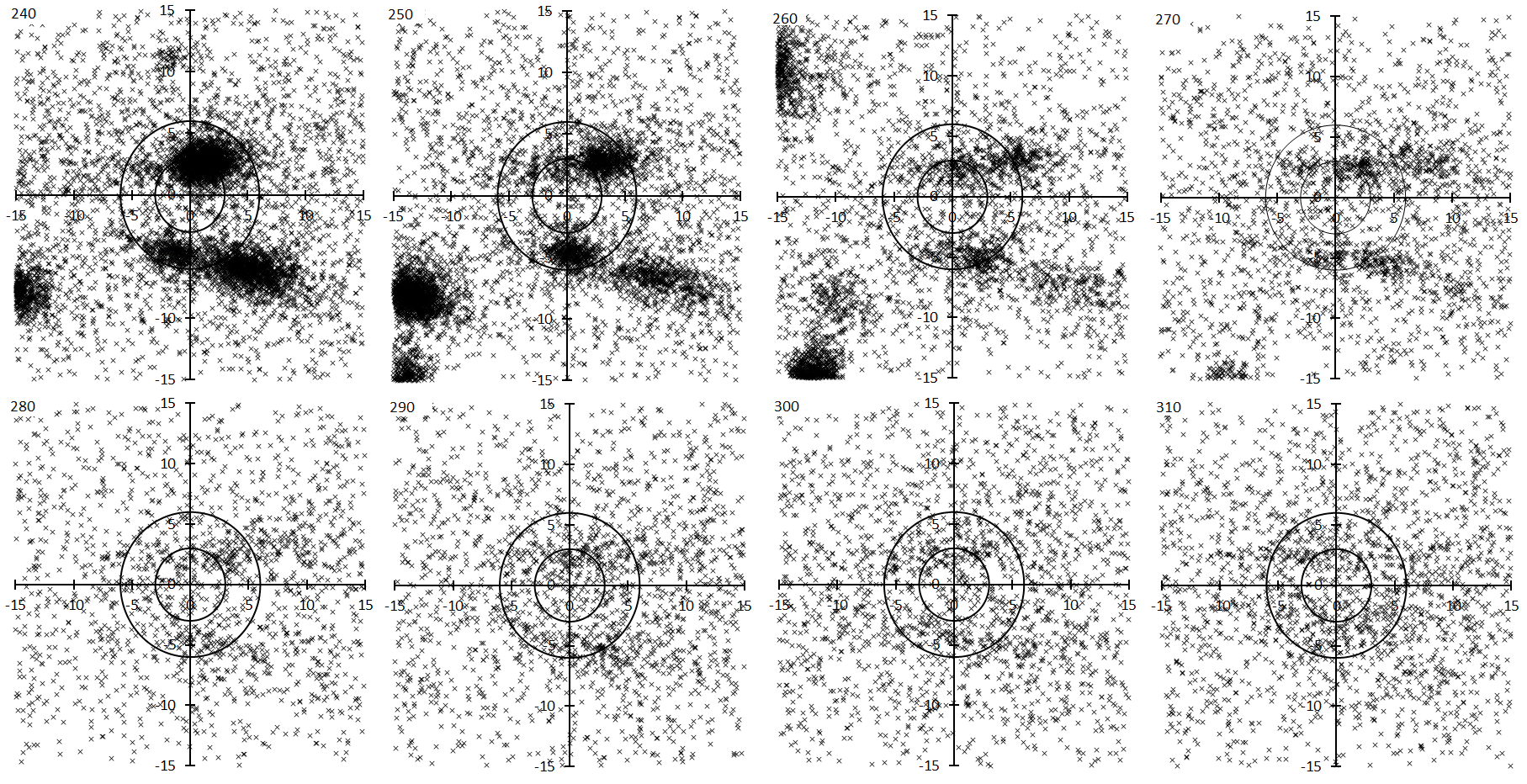
Figure 20 – From Taurids to Cancrids. Radiant distribution 10 solar longitude bin centering on (λ–λʘ, β) = (190°, 0°). The middle value for each period is shown in the upper left corner of each figure.
Table 12 – NCC and SCC in the IAU MDCSD; “ot” means observation technique.
| Code | a | d | vg | λʘ | λ–λʘ | b | Notes | ot | References |
| 0096NCC00 | 130 | 20 | 25.67 | 297 | 190.17 | 1.57 | *1 | V | 1] Arlt R.,1995 |
| 0096NCC01 | 134.19 | 14.2 | 26.7 | 300.2 | 192.38 | -2.94 | *2 | R | 2] Nilsson, 1964 |
| 0096NCC02 | 126.72 | 19.92 | 28 | 297.1 | 187.11 | 0.73 | *3 | P | 3] Lindblad, 1971 |
| 0096NCC03 | 124.83 | 20.92 | 25.8 | 292.9 | 189.35 | 1.3 | *4 | R | 4] Sekanina, 1973 |
| 0096NCC04 | 130.52 | 19.71 | 26.4 | 297.1 | 190.62 | 1.42 | *5 | R | 5] Sekanina, 1976 |
| 0096NCC05 | 131.4 | 17.6 | 27.73 | 299 | 190.08 | -0.4 | *6 | V | 6] Molau et al., 2013 |
| 0096NCC06 | 127.6 | 21.5 | 27.2 | 296 | 188.63 | 2.47 | *7 | T | 7] Jenniskensetal., 2016 |
| 0096NCC08 | 128.6 | 20.4 | 28.2 | 296.9 | 188.9 | 1.63 | T | 9) Shiba, 2022. | |
| 0097SCC00 | 131.68 | 11.91 | 24.36 | 305.7 | 185.15 | -5.82 | *8 | P | 1] Terentjeva, 1989 |
| 0097SCC01 | 118.87 | 7.63 | 24 | 297 | 182.41 | -12.91 | *9 | R | 2] Nilsson, 1964 |
| 0097SCC02 | 131.5 | 10.6 | 26.43 | 298 | 193.02 | -7.13 | *10 | T | 3]Molau & Rendtel, 2009 |
| 0097SCC03 | 125 | 14.4 | 27 | 296 | 187.9 | -5.02 | *11 | T | 4] Jenniskens et al., 2016 |
| 0097SCC05 | 117.5 | 16.1 | 27.9 | 287.1 | 189.34 | -4.85 | T | 6) Shiba, 2022. |
Notes:
*1: In Arlt 1995 the shower name is delta-Cancrids, member of delta-Cancsrids group (#95 in 2006 PJ)
*2: In Nilsson 1964, Tab 4 radiant 61.1.1, member of delta-Cancrids group (#95 in 2006 PJ)
*3: member of 96
*4: In Sekanina 1973, the shower name is delta-Cancrids (p. 255 & 258) member of delta-Cancrids group (#95 in PJ 2006)
*5: In Sekanina 1976, the shower name is delta-Cancrids (Tab. VI, p. 274), member of delta-Cancrids group (#95 in PJ 2006)
*6: member of 95/DCA group
*7: ecliptic antihelion source, member of delta-Cancrids group (#95 in PJ2006)
*8: In Terentjeva 1989 in Tab.1 alpha-Cnc(a), member of delta-Cancrids group (#95 in PJ2006)
*9: In Nilsson 1964, Tab 4 radiant 61.1.2,, member of delta-Cancrids group (#95 in PJ2006)
*10: ecliptic antihelion source, twin of 204/DXL, member of delta-Cancrids group (#95 in PJ2006)
*11: ecliptic antihelion source, twin of 204/DXL, member of delta-Cancrids group (#95 in PJ2006)
Table 12 lists what is considered NCC and SCC in the IAU MDCSD. The notes section is lively, showing that this activity can be interpreted in any number of ways. It can be seen that various interpretations have been made by researchers since the 1960s (Koseki, 2023b). The fact that Terentjeva’s most important work is not cited in the IAU MDCSD is an indication of the bias of the material; Терентьева, А.К., 1966, ‘Исследование Метеоров’, No.1, 62-132.
In any case, (λ–λʘ, β) = (190°, 0°) is at the center of ANT, and it is unclear what NCC or SCC refers to. Although NCC and SCC were listed in the previous meteor shower table (Koseki, 2021), they are excluded in this article. NCC and SCC are not featured in SonotaCo net J14 list either. On the other hand, GMN lists both.
Acknowledgment
This paper would not have been possible without the dedicated efforts of the observers, and the author would like to express his heartfelt gratitude to the members of SonotaCo net and GMN (Vida et al., 2019; 2020; 2021).
References
Asher D. J. and Clube S. V. M. (1993). “An extraterrestrial influence during the current glacial-interglacial”. Quarterly Journal of the Royal Astronomical Society., 34, 481–511. See also “Taurid swarm years”, http://www.cantab.net/users/davidasher/taurid/swarmyears.html.
Denning W.F. (1899). “General Catalogue of the Radiant Points of Meteoric Showers and of Fireballs and Shooting Stars observed at more than one station”. Memoirs of the Royal Astronomical Society, 53, 201–293.
Ellyett C. D. and Roth K. W. (1955). “The Radar Determination of Meteor Showers in the Southern Hemispheres”. Australian Journal of Physics, 8, 390–401.
Jacchia L. G., and Whipple F. L., (1961). “Precision orbits of 413 photographic meteors”. Smithsonian Contributions to Astrophysics, 4, 97–129.
Jenniskens P. (2006). Meteor Showers and their parent comets, Cambridge.
Jenniskens P., Nénon Q., Albers J., Gural P. S., Haberman B., Holman D., Morales R., Grigsby B. J., Samuels D. and Johannink C. (2016). “The established meteor showers as observed by CAMS”. Icarus, 266, 331–354.
Jenniskens P., Nénon Q., Gural P.S., Albers J., Haberman B., Johnson B., Holman D., Morales R., Grigsby B.J., Samuels D., Johannink C. (2016b). “CAMS confirmation of previously reported meteor showers”, Icarus, 266, 355–370.
Koseki M. (2009). “Meteor Shower Records: A Reference Table of Observations from Previous centuries”. WGN, the Journal of the IMO, 37, 139–160.
Koseki M. (2012). “Three components of ‘Taurids’”, WGN, the Journal of the IMO, 40, 129–138.
Koseki M. (2020). “Three components of ‘Taurids’ II”, WGN, the Journal of the IMO, 48, 36–46.
Koseki M. (2021). “The activity of meteor showers recorded by SonotaCo Net video observations 2007–2018”. eMetN, 6, 91–246.
Koseki M. (2022). “Global Meteor Network: Outburst produced by dust from 73P/Schwassmann-Wachmann3”. eMetN, 7, 369–378.
Koseki M. (2023a). “Major meteor showers based on Global Meteor Network data”. eMetN, 8, 231–245.
Koseki M. (2023b). “Remaining problems in IAUMDC Shower Database (SD)”, eMetN, 8, 288–309.
Southworth R. B. and Hawkins G. S. (1963). “Statistics of meteor streams”. Smithsonian Contributions to Astrophysics, 7, 261–285.
Vida D., Gural P., Brown P., Campbell–Brown M., Wiegert P. (2019). “Estimating trajectories of meteors: an observational Monte Carlo approach – I. Theory”. Monthly Notices of the Royal Astronomical Society, 491, 2688–2705.
Vida D., Gural P., Brown P., Campbell–Brown M., Wiegert P. (2020). “Estimating trajectories of meteors: an observational Monte Carlo approach – II. Results”. Monthly Notices of the Royal Astronomical Society, 491, 3996–4011.
Vida D., Šegon D., Gural P. S., Brown P. G., McIntyre M. J. M., Dijkema T. J., Pavletić L., Kukić P., Mazur M. J., Eschman P., Roggemans P., Merlak A., Zubrović D. (2021). “The Global Meteor Network – Methodology and first results”. Monthly Notices of the Royal Astronomical Society, 506, 5046–5074.
Whipple F.L. (1940). “Photographic Meteor Studies. III. The Taurid Shower”. Proceeding of the American Philosophical Society, 83, No.5, 711–745.
Wright F. W., Jacchia L. G., & Whipple F. L. (1957). “Photographic ι-Aquariid meteors and evidence for the northern ι Aquariids”. Astronomical Journal, 62, 225–233.

